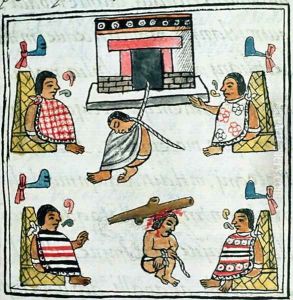Bernardino de Sahagun Paintings
Bernardino de Sahagún, born Bernardino de Rivera, Ribera, Ribeira, or by his religious name Bernardino de Sahagún, was a pioneering Franciscan friar, missionary, and ethnographer in the New World, particularly known for his comprehensive work on the culture, language, rituals, and society of the Aztec people. Born in 1499 in Sahagún, Spain, he adopted the name of his hometown as his surname.
After joining the Franciscan Order, Sahagún was sent to New Spain, present-day Mexico, in 1529 as part of a group of Franciscan missionaries. His work there coincided with the aftermath of the Spanish conquest of the Aztec Empire, a period of significant cultural and social upheaval for the indigenous populations. Sahagún is most renowned for his dedication to understanding and documenting the Aztec civilization, which he did by learning Nahuatl, the Aztec language, and immersing himself in their culture.
His most significant contribution is the 'Historia general de las cosas de la Nueva España' (General History of the Things of New Spain), commonly referred to as the Florentine Codex, named after the manuscript's home in the Laurentian Library in Florence, Italy. This magnum opus is an encyclopedic work that covers various aspects of Aztec life, including religion, cosmology, rituals, economics, social structures, natural history, and the conquest itself. Sahagún collaborated closely with indigenous scholars and elders, relying on their knowledge and employing a team of Nahua students to gather information, translate, and illustrate the text, which was written in both Spanish and Nahuatl.
Sahagún's work was not only an ethnographic study; it was also a linguistic and pedagogical endeavor. He aimed to train other missionaries in the Nahuatl language and culture to aid in the conversion of the indigenous people to Christianity. To this end, he produced grammars, dictionaries, and catechisms in Nahuatl. His dedication to preserving the Nahuatl language has made his work an invaluable resource for the study of the language and its literature.
Despite the religious motivations behind his work, Sahagún approached his studies with a level of objectivity and respect for the indigenous culture that was remarkable for his time. His work provides an unparalleled insight into pre-Columbian history and has been crucial in the study of Mesoamerican cultures. Sahagún's writings have been analyzed and revered by historians, linguists, anthropologists, and ethnohistorians.
Bernardino de Sahagún passed away on February 5, 1590, in Tlatelolco, New Spain. His legacy is that of a scholar who bridged two worlds, preserving a detailed record of a civilization at the twilight of its existence. The Florentine Codex remains one of the most important and comprehensive sources of information on pre-conquest Aztec life and is considered a cornerstone of Mexican history and anthropology.
